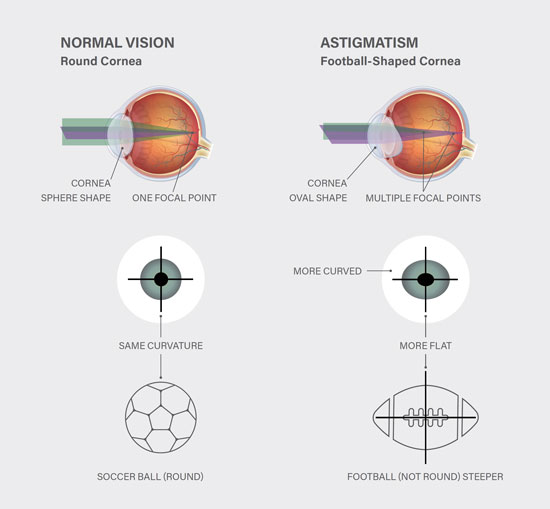 WHAT IS ASTIGMATISM?
WHAT IS ASTIGMATISM?
Astigmatism is a very common eye condition affecting up to 40% of people who wear glasses. 30% of people are born with it.
Astigmatism means the cornea is shaped more like a football or egg (oblong in shape), rather than a soccer ball (round in shape).
A round cornea is the perfect shape because it allows light to enter the eye as a single ray, and therefore focussed on the retina as a single, sharp point.
When the cornea is an oblong shape, light enters at multiple points of focus, between the steep and flat curvatures. As a result, the image on the retina is distorted.
The Retina is the back of the eye. The Cornea is the clear window on the front of the eye.
WHAT ARE THE SYMPTOMS OF ASTIGMATISM?
The most common symptom of astigmatism is blurred or irregular vision.
People with astigmatism can also experience headaches, eye strain, squinting and eye irritation.
HOW TO TREAT ASTIGMATISM?
Astigmatism can be corrected non-surgically by wearing either glasses or contact lenses.
It can also be corrected for permanently. This is usually done at the time of cataract surgery by using a specialised type of IOL called a ‘toric IOL’. Toric IOLs facilitate sharper and better-quality vision without glasses, compared to a regular or non-toric IOLs.
Utilising a combination of a “Toric IOL” and a detailed surgical plan provide patients with optimal vision after cataract surgery. In most cases without the need to wear glasses.
EYE CONDITIONS
EYE HEALTH IN THE NEWS
How to protect your Eyes this Summer
Why Protect your Eyes? The Australian summer is hard to compete with. Our warm weather, pristine beaches, and outdoor lifestyle mean we spend a lot o READ MORE >
Sharpening up on Diabetes & Eye Injections
What is Diabetic Macular Oedema? There are many different eye conditions which may bring the eye-opening news that your treatment is going to involve READ MORE >
Easter Bunny Special: The myth behind the carrot & Vision
A History of the Carrot and Vision In the Easter spirit, we thought we’d take the time this month to shed some light on a timely old wives’ tale about READ MORE >




